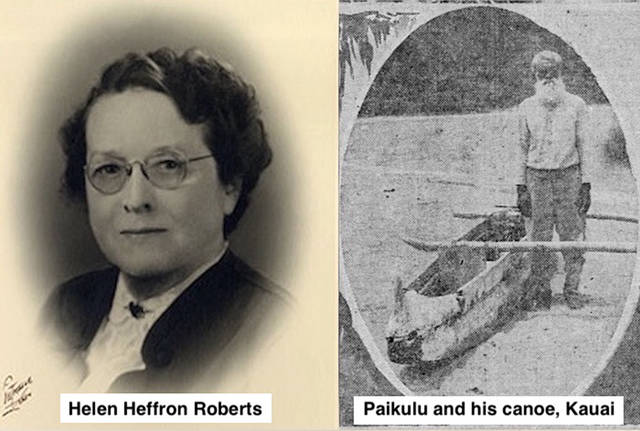During 1923 and 1924, Miss Helen Heffron Roberts (1888-1985), a trained musician and anthropologist headquartered at the Bishop Museum, Honolulu, recorded for the first time over 700 ancient mele and oli chanted by aged Hawaiians throughout the Hawaiian Islands, which are archived for posterity on wax cylinders at Bishop Museum.
During 1923 and 1924, Miss Helen Heffron Roberts (1888-1985), a trained musician and anthropologist headquartered at the Bishop Museum, Honolulu, recorded for the first time over 700 ancient mele and oli chanted by aged Hawaiians throughout the Hawaiian Islands, which are archived for posterity on wax cylinders at Bishop Museum.
Her work, done on behalf of the Hawaiian Folklore and Legends Commission, preserved mele and oli that would soon have been lost to the world forever through the deaths of the few elderly Hawaiians able to chant properly and who truly knew very old mele and oli — the means by which Hawaiians had once handed down their history from generation to generation.
The elderly Hawaiians she sought were at first wary of sharing their songs and chants, some of which they considered sacred, but Roberts was able to win their confidence, and as her work became more familiar to Hawaiians, she received many letters requesting that she visit them so that they might impart their knowledge to her.
Among the Hawaiians on Kauai sharing mele with Roberts were Kamehaitu Helela of Hanapepe Valley, Mrs. Hona of Waimea, Paikulu and Wahine Keouli Paa of Haena, Mrs. Koiahi of Hanalei River Valley, and Mr. and Mrs. J. Ulumui Ilalaole of Makaweli Valley.
In gratitude, she wrote, “Thanks are due not only to those Hawaiians who chanted, but to those others who, realizing the value to science, literature and their own posterity of these recordings of their race, have loaned their collections of meles, copies of which will be persevered in the Bishop Museum.”
Roberts, who had previously done similar work recording Jamaican Maroons and the Puebloan peoples of the American Southwest, also took voluminous notes while collecting mele in Hawaii and transcribed them into her book on the subject, “Ancient Hawaiian Music,” published in 1926, which contains a detailed analysis of ancient Hawaiian musical instruments, such as the nose flute and ukeke, and musical scores of the notes of ancient chants, along with many illustrations.
•••
Hank Soboleski has been a resident of Kauai since the 1960s. Hank’s love of the island and its history has inspired him, in conjunction with The Garden Island Newspaper, to share the island’s history weekly. The collection of these articles can be found here: https://bit.ly/2IfbxL9 and here https://bit.ly/2STw9gi Hank can be reached at hssgms@gmail.com.


